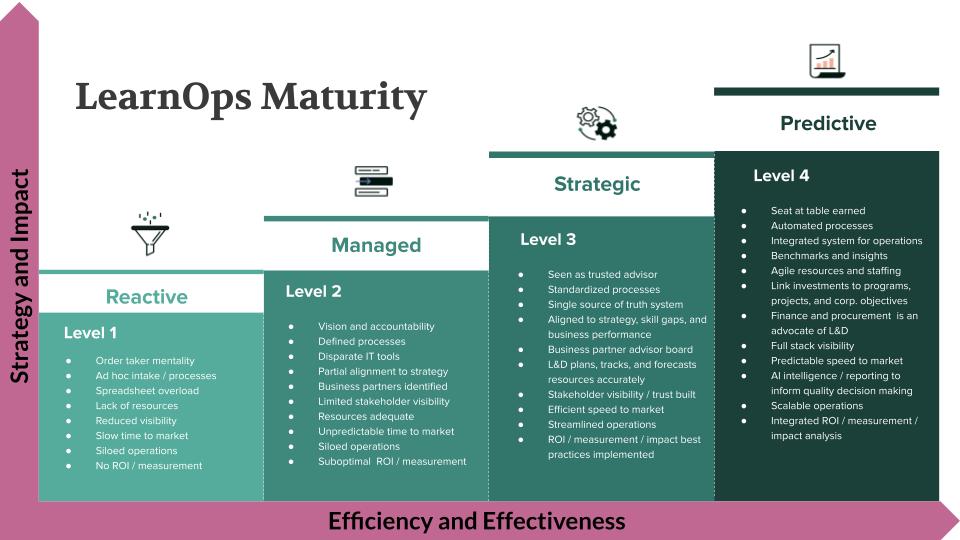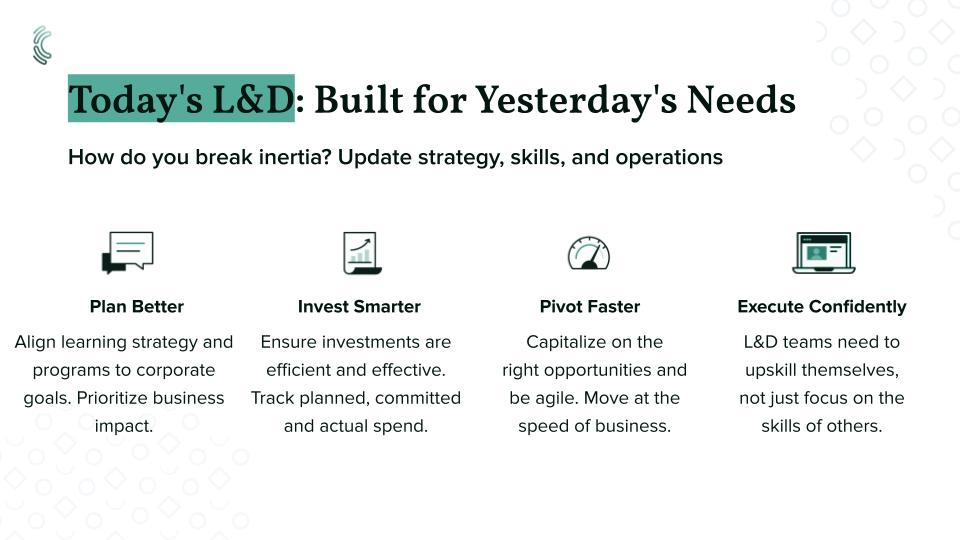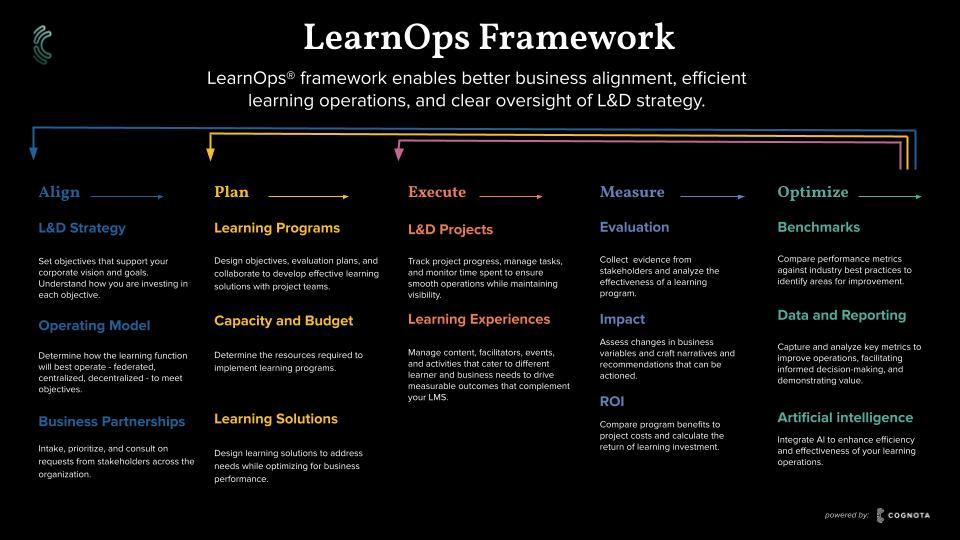Your four-step guide to transforming L&D from support function to key driver of business success, by Ryan Austin
In today’s dynamic and competitive business landscape, learning and development (L&D) is increasingly being recognised as a strategic function vital to an organisation’s growth and sustainability. However, many organisations struggle to move beyond basic, reactive L&D operations.
The LearnOps Maturity model provides a comprehensive roadmap for elevating L&D from a support function, or in some cases a cost centre, to becoming a key driver of business success. This model, consisting of four maturity levels – reactive, managed, strategic and predictive – guides organisations in systematically enhancing their learning operations.
In this article, I will expand on the concepts introduced in my previous article for Training Journal, where I discussed the strategic advantages of leveraging LearnOps for competitive edge, and delve into practical steps for advancing through each stage of the maturity model.
Level 1: Reactive – overcoming the order-taker mentality
Organisations at the reactive stage of the LearnOps Maturity model typically operate with an order-taker mentality. L&D teams are inundated with ad hoc requests, leading to disjointed processes, spreadsheet overload, and a lack of strategic alignment. The focus is on responding to immediate needs rather than proactively shaping the learning agenda. This results in reduced visibility and a slow time to market, as well as a failure to measure ROI or demonstrate the impact of learning programmes.
Moving forward
To transition out of the reactive stage, L&D teams must first establish a clear vision and accountability structure. This involves identifying key business partners and beginning to document and standardise processes. A critical step here is the creation of a centralised intake system for learning requests, which allows the L&D team to track, prioritise, and consult on business needs more effectively. This system should capture essential data points such as the origin of the request, the business problem it aims to solve, and expected outcomes. By implementing this structured approach, L&D can begin to move away from the chaos of reactive operations and start laying the groundwork for more strategic engagement.
In my previous article, I also emphasised that the shift from a reactive to a more strategic L&D function is not just about implementing processes but about changing the mindset of the entire team. This involves recognising that every learning investment should have a clear connection to business outcomes. As L&D professionals begin to think more strategically, they will be better equipped to move beyond firefighting and start contributing to the organisation’s broader goals – increasing the probability of success of meeting mutual goals.
Level 2: Managed – Building the foundation for strategic alignment
At the managed level, organisations have made significant strides in establishing vision and accountability. Processes are more defined, and there is a growing recognition of the need for alignment between learning programmes and business goals. However, challenges remain, such as the use of disparate IT tools and partial alignment to strategy. Resources may be adequate, but unpredictable time to market and suboptimal ROI measurement still hinder progress.
Practical steps
To advance from managed to strategic, L&D teams should focus on integrating their processes and tools. This means moving from disparate IT systems to a single source of truth, where all learning investments are tracked and managed. A centralised learning operations platform (LearnOps) can serve this purpose, providing visibility into learning initiatives and ensuring consistency in execution. Additionally, L&D teams should start forming a business partner advisory board. This board, comprising key stakeholders from various departments, plays a critical role in aligning learning programmes with business objectives and ensuring that learning investments are targeted where they can have the most significant impact.
The transition to a managed state is also about shifting the L&D mindset. It’s essential to begin thinking of learning as a performance improvement programme rather than just a series of training sessions. This mindset shift is critical as L&D teams work to build trust with business leaders and demonstrate the strategic value of their investments.
Moreover, the strategic L&D blueprint discussed in my earlier article is particularly relevant at this stage. I pointed out that “L&D teams must focus on creating a clear line of sight between learning investments and business outcomes.” This is the essence of the managed level – ensuring that every learning activity is not only executed efficiently but also contributes to broader business goals. By establishing strong partnerships with key business stakeholders and aligning learning solutions with the company’s strategic objectives, L&D can transition smoothly into the strategic phase.
Level 3: Strategic – Becoming a trusted adviser
The strategic stage marks a significant transformation in how L&D is perceived within the organisation. At this level, L&D teams are seen as trusted advisers, playing a proactive role in shaping the learning strategy to support business goals. Processes are standardised, and a single source of truth system is in place, allowing for efficient tracking and management of learning programmes and resources (including where time is spent and money is invested). Importantly, learning solutions are now aligned with business performance, and L&D plans, tracks, and forecasts resources with accuracy.
Strategies for success
To solidify their position as trusted advisers, L&D teams at the strategic stage should focus on deeper partnership with the overall business operations. This involves regular consultations with business leaders to understand evolving needs and proactively designing learning solutions that address skill gaps and drive business performance. The use of predictive analytics can play a crucial role here, enabling L&D to anticipate future learning needs based on business trends and workforce data.
One of the key practices at this stage is the establishment of learning advisory boards, as highlighted in my previous article. These advisory boards, which include stakeholder representatives from across the organisation, help ensure that learning investments are aligned with both immediate and long-term business goals. Moreover, they provide a forum for discussing and prioritising learning investments, ensuring that L&D resources are allocated efficiently and effectively.
Another critical aspect of the strategic stage is the measurement and communication of ROI. L&D teams should implement evaluation processes that not only assess the effectiveness of individual learning programmes but also demonstrate their impact on business outcomes. This requires linking learning metrics to key business outcomes such as revenue growth, customer satisfaction, and employee retention – or other outcomes that were predefined in earlier processes (see LearnOps Framework below). By doing so, L&D can provide actionable insights that drive continuous improvement and further strengthen their role as strategic partners.
Incorporating predictive analytics into the strategic phase is an evolution that will take some work, as share in my Forbes article. The ability to predict learning needs based on data trends allows L&D to move from a reactive mode to a more proactive and strategic approach. This transition not only increases the efficiency of learning programs but also enhances their relevance and impact on the organisation’s overall success.
Level 4: Predictive – Harnessing the power of data and AI
The pinnacle of the LearnOps Maturity model is the predictive stage, where L&D operations are fully integrated with business strategy and driven by data and AI. At this level, L&D has earned a seat at the table, with automated processes, integrated partnerships and systems, and benchmarks providing the foundation for agile resource management and staffing. Investments in learning are directly linked to corporate objectives, and L&D is seen as a key driver of business success.
Achieving predictive maturity
Reaching the predictive stage requires a significant investment in technology and data analytics capabilities. L&D teams must adopt integrated systems that provide full visibility into learning operations, from initial requests to final outcomes. AI and machine learning can be leveraged to automate routine tasks, such as the prioritisation of learning requests, freeing up L&D professionals to focus on more strategic activities.
One of the most powerful tools at this stage is predictive analytics, which enables L&D teams to forecast future learning needs and align them with business goals proactively. By analysing historical data and current trends, L&D can identify potential skill gaps before they become critical and design targeted learning interventions to address them. This proactive approach not only improves the efficiency of learning operations but also enhances the overall agility of the organisation.
In addition to predictive analytics, L&D teams at the predictive stage should focus on integrating their systems with other business functions, such as finance and procurement. This integration allows for a more comprehensive view of learning investments and their impact on the organisation. It also facilitates the optimisation of tail spend, as mentioned in my Forbes article, by identifying redundant expenditures and streamlining vendor management processes.
In my Training Journal article, I stressed that “linking learning investments directly to corporate objectives allows organisations to demonstrate the strategic value of L&D and ensure that learning initiatives are not just a cost centre, but a vital component of business success.” This insight is the driving force behind the predictive stage. By aligning L&D with the organisation’s financial and strategic goals, L&D teams can secure their place as indispensable partners in achieving long-term success. You need to have a strong relationship with the CFO office and procurement officer to achieve this.
Finally, the predictive stage is characterised by a strong emphasis on measurement and impact analysis. L&D teams must develop reporting capabilities that provide real-time insights into the effectiveness of learning programmes and their contribution to business objectives. These insights should be used to inform strategic decision making, ensuring that learning remains a key driver of competitive advantage.
The journey to LearnOps excellence
The LearnOps Maturity model offers a clear path for organisations looking to elevate their L&D operations from a reactive, order-taker function to a predictive, strategic partner. By systematically progressing through the stages of maturity – reactive, managed, strategic and predictive – L&D teams can transform their operations, align learning programmes with business goals, and demonstrate measurable impact.
The key to success lies in adopting a strategic mindset and leveraging the power of technology and data. By doing so, L&D teams can not only improve their efficiency and effectiveness but also position themselves as essential contributors to the organisation’s long-term success. The journey to LearnOps excellence is challenging, but the rewards – in terms of business impact, strategic influence, and organisational agility – are well worth the effort.
By applying these principles and following the maturity model, L&D teams can ensure that they are not just keeping pace with the demands of the business but are actively driving its success. This transformation from a reactive to a predictive approach in L&D is the future of learning operations and is crucial for organisations that want to maintain a competitive edge in the rapidly evolving business environment.
Ryan Austin is Founder and CEO of Cognota.







